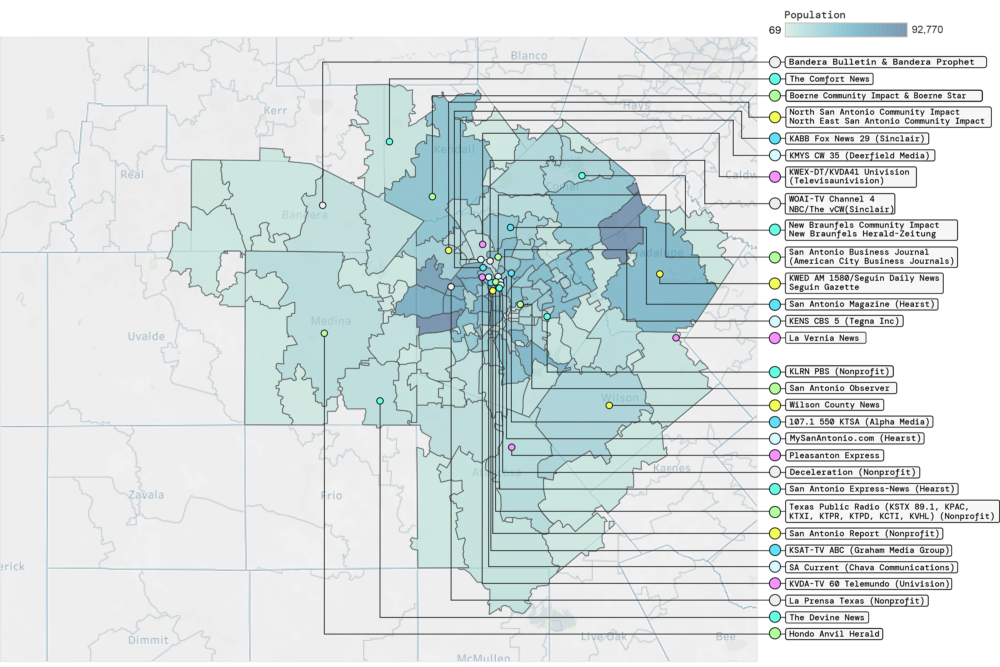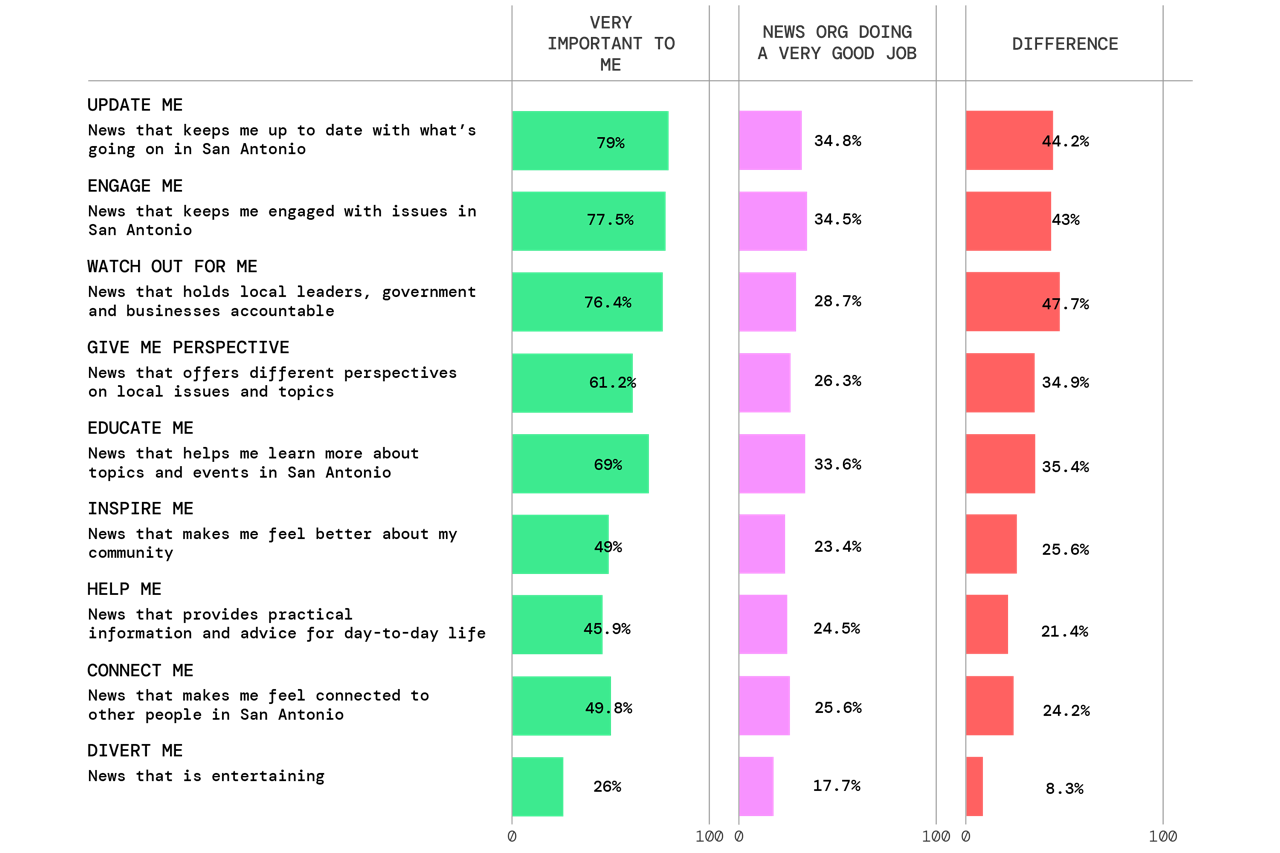Reimagining local news in the heart of Texas: What we learned researching San Antonio’s media landscape

At the News Revenue Hub, we believe that strong local journalism is essential to thriving communities. But what does strong local journalism look like in 2025?
To help communities across the country answer that question, the Hub is working with funders, civic leaders, and newsrooms to better understand what residents need from their local news ecosystem.
In San Antonio, Texas, our study of local news, commissioned by the San Antonio Area Foundation, focused on three core areas: a survey of residents about their local news habits and perceptions, a mapping and content analysis of major outlets, and a survey and needs assessment of local newsrooms.
San Antonio is a fast-growing, culturally rich region with more than 2.76 million people and nearly one million households. Between 2012 and 2022, the metro region grew by nearly 19%, with some counties’ population jumping by as much as 30-60%. That kind of rapid growth brings opportunity — a pressing need for reliable, accessible information.
According to the most recent data available from the Bureau of Labor Statistics, the ecosystem had roughly 150 reporters producing various forms of local reporting in 2023. While there is no official gold standard for the number of reporters needed to meaningfully serve a population, studies by both Pew Research Center and the Knight Foundation suggest that one reporter per 10,000 to 15,000 residents is a healthy minimum for robust local coverage. For a region with 2.76 million people, that means the ecosystem requires at least 184 to 276 reporters.
Taking that into consideration, here’s what we learned about the San Antonio media landscape and the information needs of its community members.
A high demand for local news — and desire for more depth
San Antonio residents’ media consumption habits reflect national trends, with more people turning to digital platforms, including social media, while still relying on traditional sources like TV news. But what they’re getting doesn’t always meet their expectations.
Many residents expressed a strong desire for more localized information — not just city-wide updates, but county-specific and neighborhood-level stories. This was especially true among rural residents, who often rely on Facebook groups or local newspapers but still feel disconnected from coverage about the rapid changes affecting their towns. As one respondent to our survey wrote: “We could easily hear more about a big train wreck in Nebraska than we might about mismanagement in a local school district.”
Across the region, people reported dissatisfaction with the scope, depth, and relevance of local coverage. They want more context, more enterprise reporting, and more investigative journalism that goes beyond the headlines.
We also found that local news is struggling to meet basic user needs. Inspired by an international study of news audience user needs, we asked San Antonio area residents to evaluate how well their local news fulfills eight key information needs. These needs are grouped into four general categories: knowledge, understanding, feeling, and doing.

The three most important information needs expressed by respondents were:
- “Update me” — Keeping people informed about what’s happening.
- “Engage me” — Connecting people to local issues.
- “Watch out for me” — Holding leaders and powerholders accountable.
San Antonio-area local news fell short across every information need, with the largest gaps in these same three areas: “update me,” ”engage me,” and “watch out for me.”
A call for better representation
One of the most notable findings was the distinct experience of Hispanic and Latino residents. These communities represent 64% of San Antonio’s population and 55% of the metro area — a defining part of the region’s identity.
While our survey sample was not fully representative, Hispanic and Latino respondents reported being highly engaged with local news, accessing it through a wide mix of digital and traditional channels. Still, their expectations were clear: they want coverage that reflects their lives, engages them directly, and holds local power accountable. They were also significantly more likely in our survey to strongly agree with the statement: “San Antonio local news coverage is more focused on problems than solutions.”
There’s a significant gap here — one that many outlets aren’t filling. Increasing representation, expanding engagement efforts, and rethinking how stories are sourced and framed are essential steps toward building deeper trust and relevance.
Local news that isn’t local
We identified 39 local news outlets producing original reporting across the eight-county metro area. Of these, 13 focus on specific areas outside of San Antonio, and four specifically serve communities of color.
To better understand how much local coverage the ecosystem is producing, we performed a content analysis on the four predominant newsrooms in the area – the San Antonio Express-News, Texas Public Radio, San Antonio Report, and KSAT. These newsrooms were also the most popular and most trusted in our community survey.
Our finding? While some are doing better than others – the San Antonio Report notably had a high degree of local coverage – much of the content residents are encountering isn’t about local issues.
Every county in the metro area received less local coverage than expected based on population, including Bexar County. The counties and cities outside the city of San Antonio, in particular, received very little news coverage focused on issues specific to those areas: Despite the extraordinary growth taking place there, most of the coverage from the predominant news outlets in those areas focused on travel and food.
Meanwhile, stories about crime, sports, and politics dominated the regional landscape, while critical subjects like education, housing, development, and climate change were consistently underrepresented — a mismatch between what residents want and what’s being published.
To meet community needs, newsrooms must shift their editorial priorities and investinvesting in more locally focused enterprise and accountability reporting, developing deeper beats, sourcing more diverse voices, and telling stories that reflect the impact of policy and development decisions at a hyperlocal level.
What San Antonio newsrooms need
Through surveying and interviewing local news leaders, we found San Antonio’s newsrooms are filled with ambition. Many are eager to grow coverage, reach new audiences, and explore new formats — but limited resources stand in the way.
Financial instability is a major concern. Most outlets rely on print advertising or philanthropic support , and few report long-term financial sustainability. Some aren’t sure whether they’ll be operating five years from now.
Even with regular publishing schedules and content across formats, many outlets report that they’re not reaching as many people as they’d like, a challenge that’s amplified in today’s fragmented digital landscape.
Geographic coverage is another hurdle. Newsrooms serving the entire metro area often have just a few staffers responsible for covering all eight counties. Outlets focused on a single county face similar staffing constraints, with one or two people juggling multiple roles.
Despite these challenges, most outlets have growth plans — they just need support to execute them. The most urgent needs include revenue-generating capacity, audience development support, and technology training and tools.
San Antonio’s media ecosystem isn’t lacking in potential. But turning potential into impact will require targeted investment, collaborative learning, and long-term commitment.
Looking ahead
This landscape analysis is one part of a bigger picture. It highlights challenges, strengths and opportunities within the local media ecosystem, and requires an ecosystem-level commitment to addressing the gaps.
Based on our research, we are recommending several potential paths forward:
- Incentivize collaboration. Increased collaboration by the newsrooms will be critical. Targeted funding could enable established organizations to create collaborative reporting networks with some of the small newsrooms in the counties. Newsrooms will need to find ways to come together as a network to fill critical information gaps in housing, education, and accountability reporting. Funders could inspire and incentivize these collaborations by rewarding additional investments based on how well the collaborations address community information needs.
- Infrastructure is essential. Our research shows residents strongly prefer digital platforms, yet many local outlets, particularly in the outlying counties, lack the technology infrastructure and expertise to meet these needs. These newsrooms need infrastructure support and training to modernize their content distribution capabilities.
- Seeding revenue potential. Local newsrooms consistently identified revenue-related staffing as their most critical need. This presents a strategic opportunity: rather than perpetual dependency on philanthropy, investments in business development positions or networks create pathways to self-sufficiency. Each dollar spent on revenue capacity now yields multiples in sustainable funding later.
These are just a few pathways the region can take to building a stronger local news ecosystem. We know it won’t be easy. As we’ve seen in other cities, the path to rebuilding and strengthening local news begins with understanding. When communities are heard, partnerships can take root. New solutions emerge. And journalism becomes not just more sustainable — but more impactful.
In San Antonio, the foundation is strong. The next step is coming together to build on it.
The Hub would like to thank the San Antonio Area Foundation for its sponsorship and partnership in this research. The Foundation’s dedication to community outreach, in particular, helped ensure diverse voices were heard throughout the reporting process and beyond.
Interested in conducting a media landscape analysis in your community? Reach out to Evan Mackinder, EVP of Business Development at [email protected].